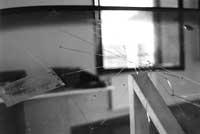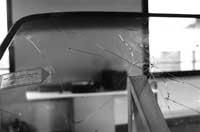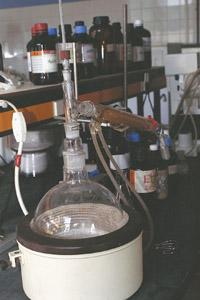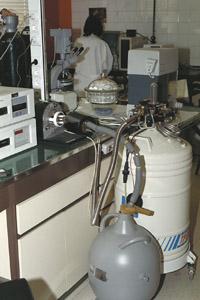Glass surgeons
1997/07/01 Kaltzada, Pili - Elhuyar Zientziaren Komunikazioa Iturria: Elhuyar aldizkaria
In fact, the members of the Department of Polymers of the Faculty of Chemistry have told us that the windshield of the car does not have to change. In it, the new photosensitization technique was carried out, which was presented in Donostia in early June. According to its own name, the luminous composition is the one that gets the new resin: the glass, as it were, is subjected to a small plastic surgery intervention. The operation is very fast and the technician only takes about 30 minutes to completely remove the gap or channel from the winds. And also to us it has seemed quite cheap.

Located in the municipal district of Hernani (Gipuzkoa), the company has put on the market the new system of photosensitization, but studies have been carried out at the Faculty of Chemistry of the UPV/EHU. Specifically, in the Polymer Section directed by Antxon Santamaría. The chemicals Mari Jose Fernandez-Berridi and Lurdes Irusta have been in charge of developing the substance that composes the windshield and we have met with everyone to contact us with a new system that will benefit our pocket.
Cetiaz-Elhuya r: The new technique totally repairs the usual cracks in the car windshield. What exactly does it consist of?
Faculty of Chemistry : That is, in prose, in the windshield of cars, hit by small stones or, therefore, "complete" with light the cracks that occur. First we remove the air from the hole that have caused the impacts on the crystal, which is, in short, the hole we see. Once the air is expelled, we inject a resin type substance. Our work has been to investigate the proper properties of this substance. To inject the chemical compound is liquid, but it must be a substance that solidifies in exposure to light. The transition of state is done by ultraviolet rays, placing a small lamp on the impact and acting directly. Another important feature of the substance is its color, or if you prefer, its absence of butts, which must be transparent in order to match it with the car crystal.
C.D. : Can each and every one of these types of cracks be repaired using this system?
C. C. F. F. : Not all. On the one hand, if there are many impacts, the crystal photosensitization process will be very long and costly. When we designed a new technique we had small impact on sight, that is, very frequent cracks in the car, no breaks. On the other hand, people ask us if this technique will also repair the windows of the house and we, with pain, tell them no. This technique is designed for the compression of laminated crystals. Due to safety measures, the windshield of the cars, mainly the front and in some cases the side ones, are laminated. Between the two glass plates is another sheet of a special polymer, more resistant than the glass itself. This is due, as has already been mentioned, to safety, since before an impact, the central hard sheet protects the passengers, avoiding the total break of the glass. Precisely for the repair of this type of crystals, this technique has been designed for the formation of laminated crystals. All current cars have windshields of this type and are increasingly common in shop windows.
C.D. : The customer, without a doubt, will be more profitable than to completely change the glass of photosination...

C. C. F. F. : Cheaper and safer. Many times for negligence, because you can't leave the car in the workshop or because it's too expensive, we don't solve that kind of impact, sometimes I happened to Nero. It does not cause any serious damage to the car and until it is more serious do not repair it. Photosensitization does not take long; the windshield is arranged in half an hour and is quite cheap, 6,000 pesetas. In addition, the new technique will contribute to the reuse that is being made today from the word to the mouth. At present they are not recycled in the windshield of the cars, as explained above, since the central sheet is a polymer and therefore incompatible with the techniques of recycling of glass. Accumulation of crystals in the workshops with the consequent increase of pollution. The life of the windshield treated with photosenalization is lengthened, since a small impact does not make the whole piece thrown into the trash.
C.D. : They tell us that the technique that seems so simple has given you a lot of work. When did you start working on this project?
C. C. F. F. : When we entered the project it took several years in the company Glassual looking for the repair technique of windshield cars. It was they who designed the technical steps that would require repair and came to us to determine the characteristics of the substance to inject. Then, about a year ago, or rather, the design of this substance was put at our disposal. Since then, we have worked in the Department of Polymers, reworking the conditions that are given in a real state in the laboratory and starting from there to know better the characteristics that the substance should have.

Gai honi buruzko eduki gehiago
Elhuyarrek garatutako teknologia





